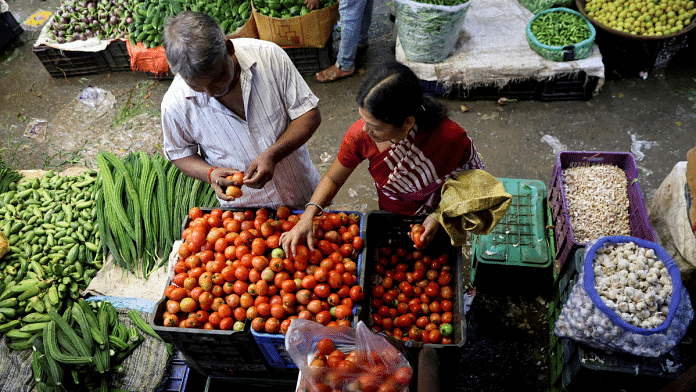New Delhi: India’s headline Consumer Price Index (CPI) this October cooled down to 0.25 percent year-on-year compared to last October, with the overall inflation rate hitting a 10-year low. In October 2024, the headline inflation was 6.21 percent.
This provisional figure reflects a reduction of 1.19 percentage points, or 119 basis points, in October’s headline CPI compared to September’s. Last month’s inflation was revised down to 1.44 percent, though the statistics and programme implementation ministry’s (MoSPI’s) provisional figure was 1.54.
The Consumer Food Price Index (CFPI) had a major impact, turning negative in October, at -5.02 percent year-on-year, and sharply pulling down overall inflation to 0.25 percent. Rural food inflation stood at -4.85 percent and urban food inflation at -5.18 percent.
In October last year, food inflation was 10.87 percent.
The overall inflation rate this October is much lower than the Reserve Bank of India’s target. The RBI is expected to slash its policy repo rate in its next policy meeting to encourage lending and spur economic growth. Earlier this year, the RBI had already cut interest rates.
Also Read: Inflation no longer dictated by just monsoon, repo rate. Why India needs a trade exposure index
Food prices turn negative & inflation drops
According to MoSPI data released this Wednesday, vegetable, cereal, and pulse prices fell significantly as more produce reached markets, after a good monsoon and better climate conditions that boosted yields. The decline was supported by a large base effect, as food prices were abnormally high at the same time last year, due to supply shocks and weather disruptions.
Another key factor was the GST rate rationalisation, with the new rates taking effect in late September. Customers began to benefit soon after the government’s decision. While India still has multiple GST slabs, the structure is being streamlined, with the 5 and 18 percent rates now covering most goods. Several daily-use items, including dairy products and stationery, were shifted to the lower five percent bracket. This indirect tax cut helped ease retail prices across several categories.
Compared with the previous month, MoSPI data showed a slight easing in inflation in housing, education, and health categories.
Based on the CPI data, CareEdge Ratings Chief Economist Rajani Sinha said, “CPI inflation continued to stay on a downward trajectory, easing to 0.3 [0.25 rounded off] percent in October, in line with our expectations. The positive impact of the GST rationalisation and deflation in the food and beverages category supported the lower inflation print.”
Deflation in the food basket deepened further to -5.02 percent in October from -0.99 percent in September, Rajani Sinha said, adding that the inflation in precious metals, however, pushed up the core CPI inflation to 4.4 percent in October. Excluding precious metals, core CPI inflation was a benign 2.5 percent, she added.
“However, the late withdrawal of the monsoon and crop damage due to heavy rains in certain regions pose some risks,” Rajani Sinha said. Double-digit inflation in the edible oil basket particularly remains a major concern against the global backdrop of elevated vegetable oil prices, she cautioned.
Crisil Ltd Principal Economist Dipti Deshpande commented, “Core inflation excluding gold should continue to serve as a better indicator of demand-side price pressures and for assessing the impact of GST rate changes. Given the sharper-than-expected fall in food inflation, expectations of healthy food supplies for the rest of the fiscal, benign global crude prices and the GST rate cut benefits on mass consumption items, we expect CPI inflation to average 2.5 percent this fiscal, significantly lower than last fiscal’s 4.6 percent.”
Although food accounts for a larger share of the overall CPI, the extent of net GST rate reduction for non-food items is greater, Despande added.
The MoSPI report also provided a state‑wise CPI map.
Kerala’s inflation highest & some projections
Taking a state-wise view, Kerala recorded the highest overall inflation in October at 8.56 percent, followed by Jammu and Kashmir (2.95 percent), Karnataka (2.34 percent), Punjab (1.81 percent), and Tamil Nadu (1.29 percent).
These figures might be indicating that, compared to Kerala, the other states experienced relatively stable food and fuel prices this month.
Speaking broadly, CareEdge Ratings Chief Economist Rajani Sinha said that on the external front, global commodity prices are likely to remain benign. This perspective she attributed to weak global growth prospects, overcapacity in China, and the Organisation of the Petroleum Exporting Countries’ decision to increase crude oil output.
She also made some projections. With the GST rate rationalisation implemented towards the end of September, its positive impact was reflected in October’s lower inflation. However, inflation is projected to average 0.9 percent in Q3 FY26 before rising to 3.1 percent in Q4 FY26.
“With food inflation remaining subdued, we project average inflation for FY26 at 2.1 percent,” she said.
From a monetary policy perspective, Ranjani Sinha said, moderating inflation gives the RBI more room to focus on supporting economic growth. This is significant, according to her, “amid continued external headwinds and uncertainties in trade negotiations with the US”.
“If growth weakens in the second half of FY26, the latest inflation readings could create scope for a rate cut,” she added.
(Edited by Madhurita Goswami)






